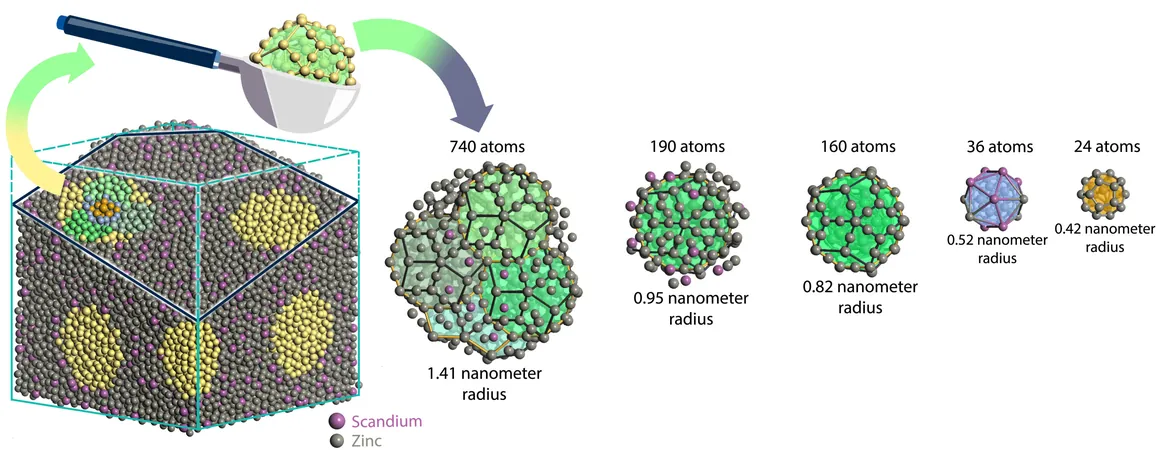
Unlocking the Mysteries of Quasicrystals: A Revolutionary Quantum Perspective
2025-06-13
Author: Jacques
A Surprising Scientific Breakthrough
In an astonishing discovery, researchers from the University of Michigan have unveiled the first quantum-mechanical model of quasicrystals, providing crucial insights into these enigmatic materials that straddle the line between crystals and glass. This groundbreaking study reveals that, under certain atomic combinations, quasicrystals can be the most stable arrangement, challenging long-held scientific beliefs.
What Are Quasicrystals?
Unlike traditional crystals, which have a repeating lattice structure, quasicrystals exhibit a unique atomic arrangement that defies periodic patterns. Initially considered impossible, quasicrystals were first identified in 1984 by physicist Daniel Shechtman, who discovered an intricate icosahedral structure in aluminum-manganese alloys, characterized by a fascinating five-fold symmetry.
From Controversy to Recognition
Shechtman's revolutionary findings were met with skepticism and resistance, as they contradicted the prevailing understanding of atomic arrangements in solids. However, further research validated his discovery, leading to the identification of quasicrystals in ancient meteorites and ultimately earning Shechtman the Nobel Prize in Chemistry in 2011. Yet, the mystery of how quasicrystals stabilize remained largely unsolved.
Cracking the Code of Stability
The researchers' breakthrough comes from a novel quantum-mechanical simulation method that goes beyond traditional density-functional theory, which relies on repeating patterns. By analyzing nanoparticles extracted from a larger simulated block of quasicrystal, the team was able to measure the total energy of these nanoparticles, determining that certain well-known quasicrystals are actually enthalpy-stabilized—meaning they achieve lower energy states.
Implications of the Findings
This discovery not only clarifies the stability mechanisms behind quasicrystals but also positions them as vital players in the materials science landscape. Understanding how to engineer atomic structures could pave the way for the development of materials with tailored properties, paving the road for innovations in industries from electronics to quantum computing.
Overcoming Computational Challenges
A key hurdle the researchers faced was the computational intensity of simulating larger nanoparticles. However, they devised a more efficient algorithm that significantly speeds up calculations by minimizing inter-processor communication. This enhancement allows for broader simulations, opening new possibilities for studying complex materials and their applications.
The Future of Material Science
With this breakthrough, the researchers can explore not only quasicrystals but also glass and amorphous materials, crystal interfaces, and defects that could ultimately contribute to advancements in quantum computing technology. The potential for these materials is vast, marking a new era in material science and offering exciting prospects for future innovations.









 Brasil (PT)
Brasil (PT)
 Canada (EN)
Canada (EN)
 Chile (ES)
Chile (ES)
 Česko (CS)
Česko (CS)
 대한민국 (KO)
대한민국 (KO)
 España (ES)
España (ES)
 France (FR)
France (FR)
 Hong Kong (EN)
Hong Kong (EN)
 Italia (IT)
Italia (IT)
 日本 (JA)
日本 (JA)
 Magyarország (HU)
Magyarország (HU)
 Norge (NO)
Norge (NO)
 Polska (PL)
Polska (PL)
 Schweiz (DE)
Schweiz (DE)
 Singapore (EN)
Singapore (EN)
 Sverige (SV)
Sverige (SV)
 Suomi (FI)
Suomi (FI)
 Türkiye (TR)
Türkiye (TR)
 الإمارات العربية المتحدة (AR)
الإمارات العربية المتحدة (AR)